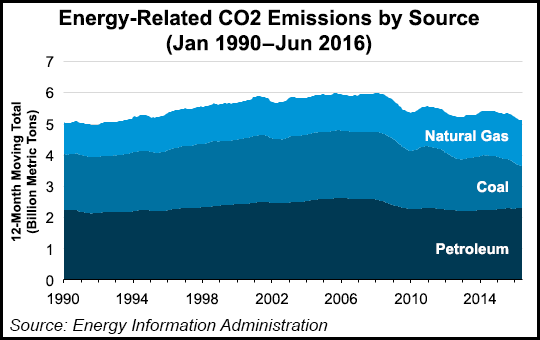Regulatory | NGI All News Access | NGI The Weekly Gas Market Report
EIA Reports Lowest CO2 Emissions From U.S. Energy Sector Since 1991
Mild weather, coupled with a steep decrease in coal consumption, contributed to the lowest level of carbon dioxide (CO2) emissions from the U.S. energy sector since the first six months of 1991, the Energy Information Administration (EIA) said Wednesday.

EIA said energy-related CO2 emissions totaled 2,530 million metric tons during the first six months of 2016. In its Short-Term Energy and Winter Fuels Outlook, released Thursday, EIA projects that emissions will fall to 5,179 million metric tons in 2016, the lowest annual level since 1992 (see related story).
During the first six months of 2016, the U.S. had the lowest number of heating degree days since at least 1949, the earliest year that EIA began keeping track of monthly data for all 50 states. Warmer weather during the winter months led to an overall 2% decline in total primary energy consumption compared to the first six months of 2015. EIA said the decrease was especially noticeable in the residential and electric power sectors, where primary energy consumption declined by 9% and 3%, respectively.
According to EIA, coal and natural gas consumption by power generators both declined compared to the first six months of 2015, but coal had the steeper drop-off at 18%. Natural gas use fell 1%. The agency added that the declines by coal and gas more than offset a 1% increase in total petroleum consumption, which had been buoyed during the first six months of 2016 by low gasoline prices.
Power generators continued to embrace renewable sources of energy. During the first six months of 2016, consumption of renewable fuels increased 9% compared to the same period in 2015. Wind energy accounted for nearly half of the increase, while hydroelectric power accounted for 35% and solar power 13%. EIA said it expects solar to see the largest capacity additions of any fuel in 2016.
Last March, EIA said wind accounted for the largest share of U.S. electric generation capacity additions in 2015, followed by natural gas and solar (see Daily GPI, March 24). Natural gas made up 30% of capacity additions in 2015, adding around 6 GW — a lower addition than in previous years. Meanwhile, wind made up 41% of capacity additions in 2015 with more than 8 GW.
© 2024 Natural Gas Intelligence. All rights reserved.
ISSN © 1532-1231 | ISSN © 2577-9877 | ISSN © 1532-1266 |
